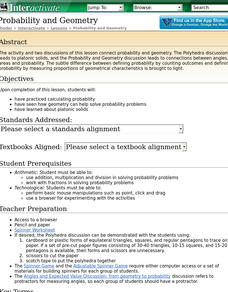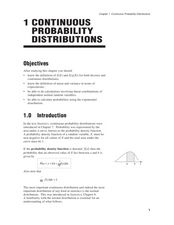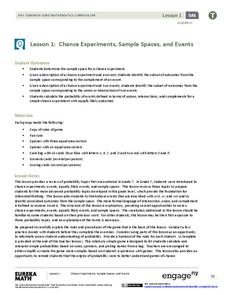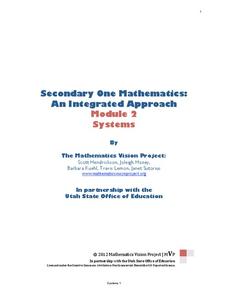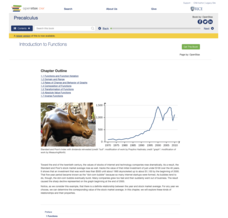Curated OER
Probability
In this statistics and probability worksheet, students determine the probability of a series of dependent and independent events occurring. The one page worksheet contains a combination of ten multiple choice and free response...
Curated OER
Permutations, Combinations, and Probability
In this probability-worksheet, 11th graders calculate the permutation, combination and probability of an event occurring. There are 5 questions with an answer key.
Curated OER
Picking Chips: Experimental Probability
Students apply the concepts of an event occurring to playing a game. In this probability lesson,students differentiate between experimental and theoretical probability.
Curated OER
Probability and Geometry
Students practice calculating probability, see how geometry can help solve probability problems and explore platonic solids.
Curated OER
Probability
In this probability and statistics learning exercise, students determine the probability of a series of independent event occurring. The one page learning exercise contains a combination of four multiple choice and free response...
Curated OER
Probability
In this probability and statistics worksheet, students determine the probability of a series of dependent events occurring. The one page worksheet contains a combination of six multiple choice and free response questions. ...
Curated OER
Evaluating Simple Probabilities
In this Statistics and Probability worksheet, students solve problems involving simple probability. The one page worksheet contains five multiple choice questions. Answers are provided.
Curated OER
Continuous Probability Distributions
In this continuous probability distribution learning exercise, students identify discrete and continuous distributions. They calculate the linear combination of the independent normal random variable and determine probabilities using...
Curated OER
The Counting Principle, Sample Spaces, and Probability
In this statistics and probability worksheet, students solve problems in which they use the counting principle and/or tree diagrams to determine the number of outcomes of an event or the probability of event occurring. The three...
Curated OER
Conditional Probability
For this probability worksheet, students use conditional probability to solve for the probability of an event occurring in a finite sample space. The one page worksheet contains five multiple choice problems. Answers are...
Curated OER
Math Regents Exam Questions: Theoretical and Experimental Probability
In this probability worksheet, high schoolers solve 19 multiple choice and short answer questions. Students find the theoretical and experimental probability of various scenarios.
Curated OER
Solving Equations Using Two Operations
Need more detail in showing your class how to solve two-step equations and proportions? This lesson plan outlines the steps young mathematicians need to solve simple equations and check their results.
Curated OER
Birthday Problem
Young scholars identify the probability of an event occurring. Learners explore the complement of an event in finding why an event will not happen. They also explore basics of probability within algebra.
EngageNY
Ruling Out Chance (part 2)
Help your classes find the significance in this lesson! Learners analyze the probability of Diff values. They then determine if the difference is significant based on their probability of occurrence.
Mathalicious
Three Shots
To foul or not to foul, that is the basketball question. High schoolers look at the probability that fouling out a player and allowing free throws yields a better outcome than allowing the original shot. The resource provides a...
Buffalo State
Adding and Subtracting Integers Unit
Just because one integer is larger than another doesn't mean it will make sense right away. Go beyond note taking and show learners, through the use of algebra tiles and a Four-Pan Algebra Balance, how the numbers relate to one...
EngageNY
Chance Experiments, Sample Spaces, and Events
Want a leg up on the competition? Show classes how to use mathematics to their advantage when playing games. Learners calculate probabilities to determine a reasonable scoring strategy for a game.
Mathematics Vision Project
Module 2: Systems of Equations and Inequalities
The brother-sister pair Carlos and Clarita need your class's help in developing their new pet sitting business. Through a variety of scenarios and concerns presented to the siblings, the learners thoroughly explore systems of equations...
Rice University
Precalculus
Take a step beyond Algebra 2. Learners use the eBook to learn concepts from the typical Precalculus course. Content starts off with a short review of functions in general and moves on to the basic functions, finishing up with more...
EngageNY
Margin of Error When Estimating a Population Proportion (part 2)
Error does not mean something went wrong! Learners complete a problem from beginning to end using concepts developed throughout the last five lessons. They begin with a set of data, determine a population proportion, analyze their result...
Virginia Department of Education
Mathematics Vocabulary Cards - Grade 2
Augment your math curriculum with posters detailing several concepts important to second grade math. Each poster features one math term from geometry, measurement, probability and statistics, computation and estimation, numbers and...
Curated OER
7-5 Practice Integration: Probability Compound Events
In this probability worksheet, students read story problems and draw tree diagrams to model the probability of compound events. After creating two tree diagrams, students compare them. They compute the probability of dependent events.
Curated OER
Ingetrated Algebra Practice
In this integrated algebra worksheet, students solve probability problems. They identify the appropriate sample space for the given experiment. This two-page worksheet contains 4 multiple-choice problems. Answers are...
Curated OER
The Probability Scale
Students collect data and make predictions. In this probability lesson, students perform experiments calculating the chance of an event occurring. They draw conclusion based on their data.





